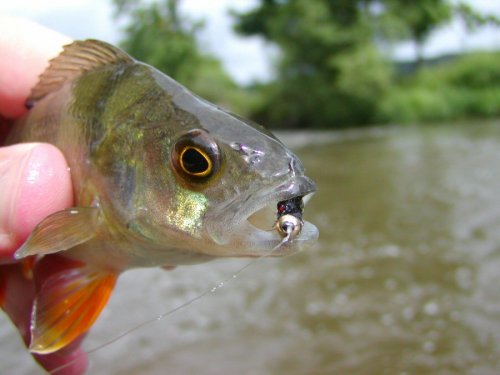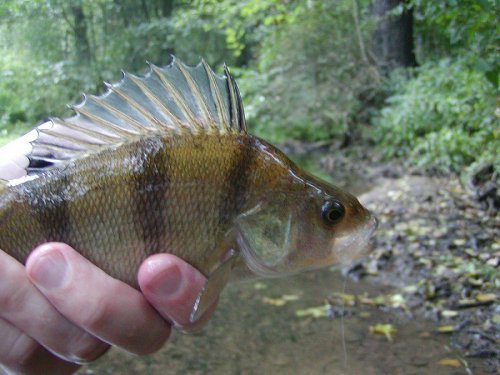Fly fishing for river perch is one of authors's favorite fishing pastimes, in addition to the hunt for trout and grayling.
Fly fishing for river perch (Perca Fluviatilis) is one of my favorite fishing pastimes, in addition to the hunt for trout and grayling. Perch can be caught year-round, even during light frosts in deeper parts of the river. When luck is with us and we happen on the right day and time, the strikes are guaranteed - and not just fingerlings, but even nice fish around 30 cm long. My largest perch caught on a fly was 38 cm.
The best time for perch fly fishing seems to be the beginning of summer, when the river water is already a bit warm and the shallows at the banks are alive with whitefish fry. The earlier one wakes up, the better for successful fishing and bigger fish. After many hours of inaction, the next big chance for fishing comes at dusk.
The second best season for perch arrives with the start of autumn and the first morning frosts, when schools of perch intensify their search for food in the cooler water. Such a hunting school of perch can’t be missed even in running waters, since in their chase for smaller fish they often swim into the shallows, where their dorsal fins rise out of the water.
Smaller and intermediate perch up to about 25 cm live and hunt in schools, and the general rule is that the larger the fish, the smaller the school. Individuals larger than 30 cm live and hunt alone, are very careful, and are rarely caught in the full light of the middle of the day. In summer, fish the transitions from deeper and slower water into the shallows; in the early morning and at dusk try the shallows also. In autumn, most fish are caught in the deep pools, above weirs, and around obstacles on the bottom such as rocks and roots.
To effectively fish for perch, I recommend a 275 – 290 cm fly rod (AFTMA 6 or 7). A stiffer rod is used when pike are also striking, which is a fairly common occurrence when fishing for perch. Using a Kevlar leader is a welcome modification of the perch set-up; when using the standard leader or fluorocarbon to increase strikes, we have to count on losing a few flies to the pikes’ sharp teeth. A “golden” middle way might be best – a heavier 0.22 to 0.27 mm fluorocarbon leader that provides at least some resistance to pike teeth. If the perch just follow the leader but don’t strike, then it’s time to move to a riskier 0.14 mm leader. This should be considered just in a pinch, though, since the chance of losing flies to sudden or heavy strikes increases dramatically.
The fly line should be chosen based on water depth and current speed. In spring and autumn, an intermediately sinking line – category II/III – is preferred, in summer an intermediate transparent line works best, and in winter a quickly sinking line of category IV/V should be used. The flies should always be moving. The speed of fly retrieval is chosen based on season and the mood of the fish. I pull in the flies much quicker in warmer summer waters than in cooler seasons. If perch just follow the fly, always speed up rather than slow the retrieve. A fish will often strike just before pulling the fly out of the water, so be especially alert and prepared.
As far as appropriate fly patterns, the best bet for perch is one large fly imitating a wounded fish plus another smaller fly for the more experienced perch. The total length of the leader should be just slightly longer than the rod length, so about 3 meters, and flies should be tied about 1 meter apart. I tie fish imitations – streamers with bright silver or gold bodies – on hooks with extended shanks in sizes from no. 8 to no. 2. Their effectiveness is enhanced by the use of variously colored marabou feathers. Smaller shiny flies for the dropper are tied like gold head nymphs with beads up to 2.5 mm in diameter.
When fishing for perch, always pay attention to the spiny dorsal fin and to the sharp edges of the gill covers. It’s always better to release them directly in the water by gripping the hook, which should always be barbless. In all cases, please remember to return all perch caught back to the water.














